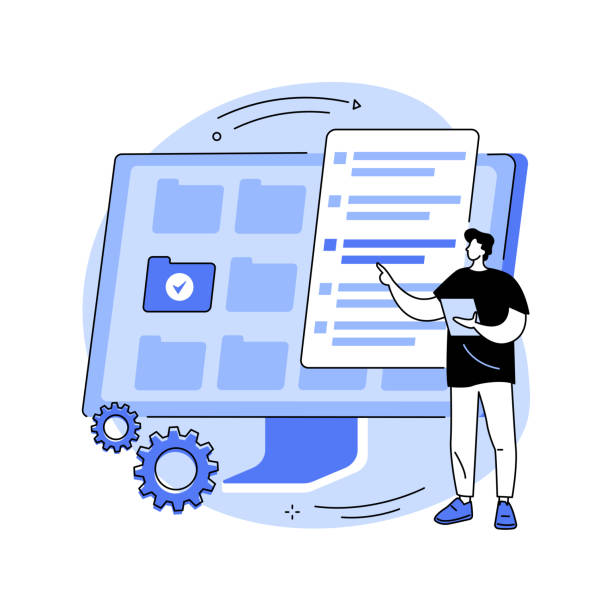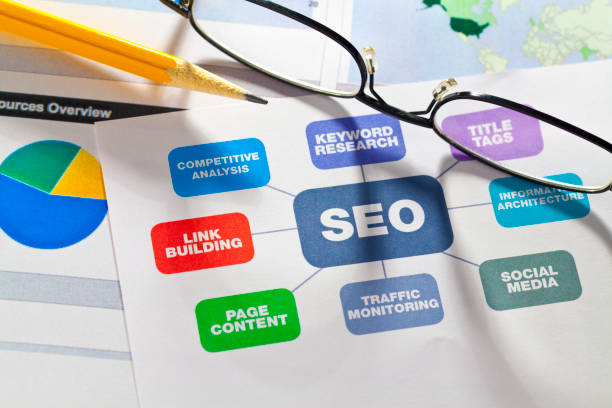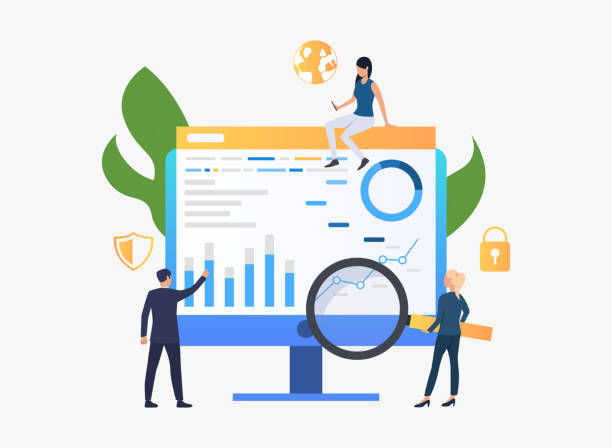Introduction to the Importance of Speed in Web Design

In today’s world, where speed is paramount, the importance of #Fast_Website_Design has become more evident than ever.
Internet users have little patience for slow websites, and a delay of a few seconds can mean losing a visitor or customer.
According to research, even a one-second delay in page loading can reduce conversion rates by up to 7%.
This not only negatively impacts user experience (UX) but can also affect your site’s ranking in search engines.
Search engines like Google consider page loading speed as an important factor in page ranking.
Therefore, website speed optimization is not just a competitive advantage, but a necessity.
This article is a comprehensive and explanatory guide for a deeper understanding of the concepts and techniques to achieve a high-speed website.
From choosing the right technologies to optimizing resource utilization, every step in the path of Search Engine Optimization (SEO) is directly or indirectly related to your website’s speed.
For an excellent user experience and better results in the digital world, fast website design should be a priority.
Are you tired of your e-commerce website not generating as much revenue as it could? RasaWeb, specialized in professional e-commerce website design, solves this problem permanently!
✅ Increase sales and revenue
✅ High loading speed and unparalleled user experience
⚡ Get free consultation for e-commerce website design
Key Factors Affecting Website Loading Speed

To achieve #High_Speed in web design, understanding the influencing factors is crucial.
This section specifically examines various elements that directly impact a website’s loading speed.
One of the most important factors is the site’s coding and structure.
Heavy, unorganized, or unoptimized HTML, CSS, and JavaScript codes can take a long time for the browser to process and render.
Using heavy frameworks or multiple unnecessary plugins can also lead to site sluggishness.
The size of images and videos, the type of hosting, the use of CDN, the number of HTTP requests, and the degree of file compression are other key factors.
For instance, if your site’s images are not optimized, they impose a large amount of data on the user, which significantly increases loading time.
Choosing a suitable and powerful #Suitable_Host along with a Content Delivery Network (CDN) can have an amazing impact on the speed of content delivery to users worldwide.
The more optimized these factors are, the smoother user experience your site will provide, and ultimately, you will achieve a fast website design.
Understanding these principles is the first step for any effort in web performance improvement.
Optimizing Images and Media to Increase Speed

One of the biggest factors slowing down websites is the improper use of images and media files.
#Image_Optimization is an educational and crucial aspect for achieving fast website design.
This optimization includes compressing images without a noticeable loss of quality, choosing the appropriate format (such as WebP instead of JPEG or PNG in some cases), and using lazy loading techniques.
Lazy loading means that images are loaded only when the user scrolls to the relevant section, not from the very beginning.
This significantly reduces initial loading time, especially on long pages with many images.
Also, using correct image dimensions (only as large as they are displayed) and removing extra information (Metadata) from image files helps reduce the overall page size.
For videos, using external hosting platforms like YouTube or Vimeo and embedding them instead of direct hosting on your own server takes a significant load off the server.
Many online and offline tools are available for image compression that can assist you in this process.
These small but important actions will have a big impact on your website’s final speed and improve the user experience.
A table comparing commonly used image formats is provided below.
| Image Format | Best Use | Speed Advantages | Potential Disadvantages |
|---|---|---|---|
| JPEG | Photos, detailed images | Small size with high compression | Quality reduction with high compression, no transparency support |
| PNG | Icons, logos, images with transparency | Excellent quality retention, transparency support | Higher size compared to JPEG for photos |
| WebP | All image types (replaces JPEG and PNG) | Much smaller size with similar or better quality | Incomplete support in older browsers |
| SVG | Icons, logos, vector graphics | Very small size, high scalability without quality loss | Only suitable for vector graphics |
The Role of Host and CDN Selection in Site Speed

Choosing #Appropriate_Hosting and using a CDN (Content Delivery Network) are two fundamental pillars in achieving fast website design.
This section, as a comprehensive guide, clarifies the importance of these two factors.
Your website hosting is where all your site’s files and data are stored.
Server quality, allocated resources (such as RAM and CPU), and bandwidth all directly impact site loading speed.
Shared hosting may be inexpensive to start, but it usually allocates limited resources, which can lead to website sluggishness during traffic spikes.
Options like VPS hosting (Virtual Private Server) or dedicated servers offer more control and better resources, significantly increasing your site’s speed.
On the other hand, a CDN is a network of servers in different geographical locations that stores your website’s static content (such as images, CSS, and JavaScript files).
When a user requests to view a page, the CDN sends the content from the server closest to the user, which reduces the physical distance and minimizes loading time.
This technique is particularly important for websites with a global audience and is a #Global solution for speeding up a site.
Companies like Cloudflare and Akamai offer powerful CDN services.
Investing in quality hosting and using a CDN is a very important step towards a high-speed website and should not be overlooked.
Are you tired of your company’s website not being seen as it deserves, losing potential customers? Solve this problem permanently with professional and effective website design by RasaWeb!
✅ Increase brand credibility and earn customer trust
✅ Attract targeted sales leads
⚡ Contact us now for a free consultation!
Reducing HTTP Requests and Utilizing Caching

One of the #specialized techniques for significantly improving fast website design is reducing the number of HTTP requests and optimizing caching.
Every time your browser loads a web page, an HTTP request is sent to the server for each file (image, CSS, JavaScript, font, etc.).
The more requests there are, the longer the page loading time will be.
To reduce these requests, techniques such as merging CSS and JavaScript files into one, using image sprites (combining several small images into one large file and using CSS to display the required sections), and optimizing HTML code can be used.
Furthermore, caching plays a vital role in increasing site speed.
Caching allows the user’s browser to temporarily store copies of static site files (such as images, CSS, and JavaScript).
On subsequent visits, instead of reloading these files from the server, the browser loads them from its cache, which drastically reduces loading time.
This is a #smart solution for increasing speed.
Using caching plugins in Content Management Systems like WordPress, or server-level caching settings, can automatically manage this process.
These actions not only improve user experience but also reduce the load on the server and contribute to the overall site performance.
These strategies are integral components of a comprehensive plan for fast website design.
The Importance of Optimized Coding and Lightweight Frameworks

In the discussion of #Fast_Website_Design, the quality of coding and the choice of frameworks play a very important role.
This aspect is examined analytically.
Heavy, unorganized, or unnecessary codes can significantly reduce a website’s loading and processing speed.
Developers should prioritize code optimization; this includes minifying CSS and JavaScript files (removing white spaces, comments, and extra characters), and avoiding duplicate or inefficient codes.
Using semantic HTML and proper DOM structuring can also help browsers render pages faster.
The choice of frameworks and JavaScript libraries is also highly important.
While large frameworks like React or Angular offer many functionalities, they can significantly increase the size of JavaScript files, which in turn lengthens initial loading time.
For projects where speed is of high importance, it might be more logical to use lighter frameworks like Vue.js or even Vanilla JavaScript (pure JavaScript without a framework) for parts of the site.
Also, asynchronous (Async) loading or deferring unnecessary JavaScript files until after the main content of the page has loaded can improve the user experience.
These #smart approaches in coding form the core of an optimized and high-speed website and directly impact the long-term stability and performance of the site.
Consequently, for fast website design, code optimization is fundamental.
Website Speed Measurement Tools and Results Analysis

To ensure achieving #Fast_Website_Design, you need tools to measure and analyze website performance.
This section reports on some of the most important and widely used speed testing tools.
Tools like Google PageSpeed Insights, GTmetrix, WebPageTest, and Lighthouse (built into Chrome’s developer tools) can provide a comprehensive view of your site’s speed status.
These tools not only provide overall performance scores but also identify specific issues causing site sluggishness (such as unoptimized images, render-blocking codes, or server problems) and suggest solutions to address them.
Each of these tools provides different information.
For example, PageSpeed Insights focuses more on user experience and Core Web Vitals (critical web factors according to Google), while GTmetrix provides a detailed Waterfall Chart of each file’s loading, which helps identify the sources of slowness.
WebPageTest also allows testing from different geographical locations and with varying connection speeds.
Regular use of these tools and accurate analysis of their results is an #essential step to identify and fix weaknesses and maintain a fast and efficient website.
This continuous approach is an inseparable part of the lifecycle of any fast website design project.
| Measurement Tool | Primary Focus | Key Features |
|---|---|---|
| Google PageSpeed Insights | Core Web Vitals and User Experience | Optimization suggestions, mobile and desktop testing |
| GTmetrix | Comprehensive performance analysis, loading details | Waterfall chart, loading video, testing from different regions |
| WebPageTest | Advanced testing and various scenarios | Testing from multiple browsers and geographical locations, video recording |
| Lighthouse (Chrome DevTools) | Performance, Accessibility, SEO, Best Practices | Comprehensive reports, runnable in browser |
User Experience and Conversion Rate with Fast Website Design

Website speed is not just a technical issue, but it directly impacts #User_Experience (UX) and ultimately the Conversion Rate.
This section, in an engaging yet very important way, examines the relationship between fast website design and business success.
Imagine entering an online store; if you have to wait a long time for every click or page load, you quickly get frustrated and leave.
The same happens in the online world for slow websites.
Users are looking for ease and speed, and high-speed websites convey a sense of satisfaction and efficiency to them.
Fast websites have a lower Bounce Rate, meaning fewer users leave the site immediately after entering.
Also, they spend more time on the site, view more pages, and are more likely to take your desired action (such as purchasing, signing up, or filling out a form).
This translates to an increased conversion rate.
From a digital marketing perspective, a #Speed_Optimized_Site is a powerful tool for attracting and retaining customers.
Even small changes in loading speed can make significant differences in the final results.
This is an investment that offers a substantial return and demonstrates that speed is king, and for any business seeking online success, fast website design is an undeniable priority.
Did you know that 94% of a first impression of a company is related to its website design?
RasaWeb helps you create the best first impression by offering professional corporate website design services.
✅ Create a professional and trustworthy image for your brand
✅ Easily attract potential customers and improve online presence
⚡ Get free consultation for corporate website design right now!
Common Challenges and Solutions in Speed Optimization

On the path to achieving #Fast_Website_Design, developers face numerous challenges.
This section, presented as thought-provoking content, examines some of the most common challenges and provides practical solutions to overcome them.
One common challenge is the high volume of content, especially high-quality images and videos.
How can visual quality be maintained while increasing speed? The answer lies in optimizing formats, intelligent compression, and using a CDN.
Another challenge is the presence of render-blocking JavaScript codes that prevent the browser from displaying the page until these codes are complete.
The solution to this problem is to use async and defer attributes for script tags so that their loading does not interfere with the rendering of the main content.
Another question is how to use plugins and third-party tools without reducing site speed? Many websites use numerous plugins (especially in WordPress) or tracking and advertising tools that can severely slow down performance.
The solution is to use only essential and optimized plugins and load third-party tool codes asynchronously.
Also, server or hosting-related issues can be challenging.
Is it time to upgrade hosting or use dedicated servers? These decisions should be made based on performance data analysis and website needs.
Each of these #Speed_Dilemmas has its specific solutions, which with proper planning and execution, can lead to an exceptionally performing site.
Speed optimization is a continuous process, and by implementing these solutions, we can move towards faster website design.
The Future of Web Design and Speed in Web 3.0

A look into the future of #Web_Design and how speed will evolve in the Web 3.0 era is an analytical and fascinating topic.
As web technologies advance, expectations for speed also rise.
Web 3.0, built on concepts like blockchain, Artificial Intelligence (AI), and the Semantic Web, promises a more decentralized, intelligent, and of course, faster internet.
In this future, speed optimization will not only be limited to traditional issues like file size and HTTP requests but will also extend to the efficiency of smart contracts, the speed of data processing in blockchain networks, and the optimization of AI models.
The concept of fast website design in Web 3.0 will include rapid and secure loading of information from decentralized networks, and fast processing of user interactions with decentralized applications (dApps).
These developments require novel approaches in web architecture, the use of advanced communication protocols, and deeper infrastructural optimizations.
For example, leveraging layer 2 blockchain networks to increase transaction speed can be crucial for dApp performance.
Also, with the increased use of #Artificial_Intelligence in websites for content personalization and user experience, optimizing the response time of AI models will also become a key factor.
These new challenges and opportunities open up new horizons for web development and speed optimization specialists.
The future requires a more comprehensive and technological approach to achieving speed on the web, such that fast website design remains central.
Frequently Asked Questions
| Question | Answer |
|---|---|
| What is fast website design? | The process of building a website that loads quickly and provides a smooth user experience. |
| Why is website speed important? | Improved user experience, reduced bounce rate, increased conversion rate, and better search engine ranking (SEO). |
| What factors affect website speed? | Image size, number of HTTP requests, code optimization (HTML, CSS, JS), host speed, and browser cache. |
| How can website speed be improved? | Optimizing images, compressing files, using caching, choosing suitable hosting, and reducing unnecessary plugins. |
| How do images affect website speed? | High-volume or improperly formatted images can significantly increase page loading time. |
| What is the role of JavaScript and CSS in website speed? | Unoptimized, high-volume, or render-blocking codes can reduce page rendering speed. |
| How much does hosting affect website speed? | The speed and quality of the hosting server directly impact website response time and initial loading speed. |
| What tools are available to check website speed? | Google PageSpeed Insights, GTmetrix, Pingdom Tools are common tools. |
| What are the benefits of a fast website? | Greater user satisfaction, reduced bounce rate, increased time on site, and improved Google search ranking (SEO). |
| What are common mistakes that slow down a website? | Using unoptimized images, bulky and disorganized coding, excessive use of plugins, and not using caching. |
And other services from Rasa Web Advertising Agency in the field of advertising:
Smart Brand Identity: A creative platform for improving website traffic with attractive UI design.
Smart Direct Marketing: Professional optimization for improving SEO ranking using Google Ads management.
Smart UI/UX: Professional optimization for customer acquisition by customizing user experience.
Smart Marketplace: An effective tool for improving SEO ranking through key page optimization.
Smart Social Media: A professional solution for customer acquisition with a focus on user experience customization.
And over a hundred other services in the field of online advertising, advertising consulting, and organizational solutions.
Internet Advertising | Advertising Strategy | Advertorials
Sources
Fast Website Design and Optimization
Key Web Performance Optimization Tips
Modern Solutions in Web Development
Website Speed Optimization for SEO
? Is your business ready to leap into the digital future? RasaWeb Afarin Digital Marketing Agency, by providing comprehensive services including website design with a modern user interface, SEO, and social media management, paves the way for your success. Contact us today and transform the future of your brand.
📍 Tehran, Mirdamad Street, Next to Central Bank, Southern Kazeroun Alley, Ramin Alley, No. 6


